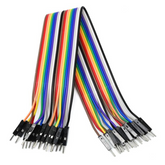Smart Dustbin using Arduino
Summary
Are you looking for a strategy to improve the efficacy of your waste management? You only need to look at this blog.
In this blog article, we will look at everything from the hardware requirements to the functioning.
Advanced sensors, analytics, and Arduino power this smart dustbin. This garbage has the potential to change how waste can be disposed of. Read further to learn more about this outstanding technology and how to get started right now.
Introduction
In this article, we will be looking at how to make a smart dustbin using Arduino, an ultrasonic sensor, and an SG-90 servo motor. Let's start!

Hardware Required
We will need the following components for making the Arduino smart dustbin:
If you don't have any of the hardware then you can click on the required component name and buy it from our store and successfully complete this smart dustbin project.
read more : Smart Security System
1. Arduino Uno

Ardunio Uno is a development board that manages all of the processing for smart dustbin projects.
2. Ultrasonic Sensor HC-SR-04
This sensor functions as an object detecting sensor. It measures the object's distance from the sensor.

3. SG-90 Servo
A Servo motor is used for moving the dust bin lid.

4. Jumper Wires
Used to do circuit connections between different components.

read more : How NRF24l01 Arduino Nano Works
Working Principle
Smart dustbin works on the principle of object detection using an ultrasonic sensor. The ultrasonic sensor transmits sound waves.
These waves get reflected whenever an object comes into the vicinity of the sensor. This generates an electrical signal which is used to open the dustbin lid.

read more : How to Setup Fingerprint Sensor with Arduino
Circuit Diagram
This is the circuit diagram for making smart dustbin. Make the connections as shown in the diagram below.

Arduino Smart Dustbin Code
Explore our carefully made code for making smart dustbin with Arduino. This program uses sensors and motors to make this Arduino project easier.
Check out our Arduino code for smart dustbin to see how it works and make your automatic dustbin project successful!
/*
SMART DUSTBIN ARDUINO CODE
Lid of the dustbin gets opened when a person comes in range of 30cm in front of the dustbin
*/
#include //INCLUDES SERVO LIBRARY
Servo servo;
int trigPin = 5;
int echoPin = 6;
int servoPin = 9;
long duration, distance, average;
long averDist[3];
void setup() {
Serial.begin(9600);
servo.attach(servoPin);
pinMode(trigPin, OUTPUT);
pinMode(echoPin, INPUT);
servo.write(0); //CLOSES CAP ON STARTING
delay(100);
servo.detach();
}
void measure() {
digitalWrite(trigPin, LOW);
delayMicroseconds(5);
digitalWrite(trigPin, HIGH);
delayMicroseconds(15);
digitalWrite(trigPin, LOW);
pinMode(echoPin, INPUT);
duration = pulseIn(echoPin, HIGH);
distance = (duration / 2) / 29.1; //CALCULATES DISTANCE
}
void loop() {
Serial.println(distance);
for (int i = 0; i <= 2; i++) { //CALCULATES AVERAGE DISTANCE
measure();
averDist[i] = distance;
delay(10);
}
distance = (averDist[0] + averDist[1] + averDist[2]) / 3;
if ( distance <= 30 ) {
servo.attach(servoPin);
delay(1);
servo.write(180);
delay(3500);
}
else
servo.write(0);
delay(1500);
servo.detach();
}
Servo motor;
This creates a servo object.
|
int trigPin = 5; |
The above lines assign trigger and echo pins of the ultrasonic sensor to 5 and 6 respectively. Servo’s PWM pin is connected to pin 9 of Arduino.
long duration, distance, average;
long averDist[3];
These are the variables created for storing and processing data from ultrasonic sensor.
|
servo.attach(servoPin); |
servo. Attach (servoPin) - attaches the servo variable which we created initially to the servo pin, set trigger and echo pins as Output and Input respectively, close the lid of the dustbin by setting servo to 0 positions, and then detach the servo object.
|
Serial.println(distance); |
Measure function calculates the distance and average calculates the average of 3 distances measured by ultrasonic sensor.
|
if ( distance <= 30 ) { |
If the distance is less than 30 then the dustbin lid is opened by setting the servo to 180 position otherwise the dustbin’s lid is closed.
read more : IR Sensor Interfacing with Arduino
Conclusion
Build your Arduino smart dustbin project to learn about innovation and cleanliness. This guide enables you to contribute to a greener, more technologically advanced future.
In this blog article, we learned that creating a smart dustbin with Arduino is a fun and creative project that not only keeps your surroundings clean but also improves your technical abilities.
With the help of ultrasonic sensors and wireless communication, you can make your daily chores more efficient and eco-friendly.
So why wait? Grab your Arduino kit and start building your own smart dustbin today! So take your first step towards becoming a tech-savvy and environmentally conscious individual. Start your journey towards a cleaner and smarter future today with this exciting Arduino project.
If you understand how to make smart dustbin using Arduino and appreciate our work don't forget to share this post and leave your opinion in the comment box.
Please do check out other blog posts about Interfacing ACS712 with Arduino , Arduino Interfacing with Ultrasonic Sensor , LED Interfacing with Arduino , Interfacing GSM Module with Arduino , Interfacing MAX30100 Pulse Oximeter with Arduino , IR Sensor Interfacing with Arduino , How to connect ZMPT101B to Arduino and How to use Buzzer with Arduino.
Make sure you check out our wide range of products and collections (we offer some exciting deals!)










